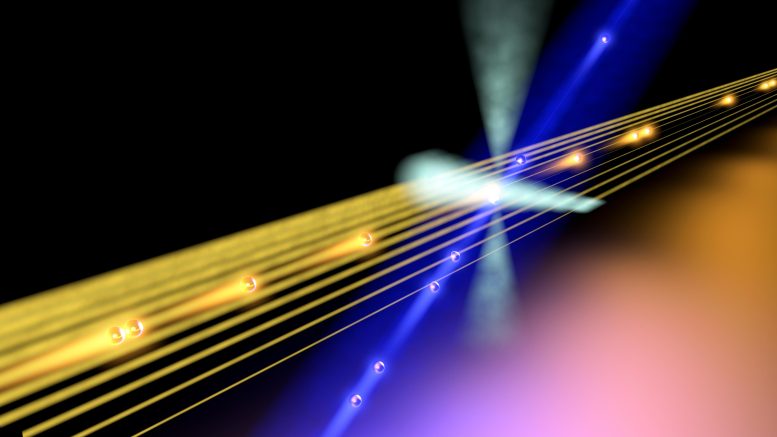
Finding offers new starting points for research into photonic quantum information systems.
An international team of researchers from Leibniz University Hannover (Germany) and the University of Strathclyde in Glasgow (United Kingdom) has disproved a previously held assumption about the impact of multiphoton components in interference effects of thermal fields (e.g. sunlight) and parametric single photons (generated in non-linear crystals).
“We experimentally proved that the interference effect between thermal light and parametric single photons also leads to quantum interference with the background field. For this reason, the background cannot simply be neglected and subtracted from calculations, as has been the case up to now,” says Prof. Dr. Michael Kues, Head of the Institute of Photonics and member of the Board of the PhoenixD Cluster of Excellence at Leibniz University Hannover.
Novel Insights into Photonics
The leading scientist was PhD student Anahita Khodadad Kashi, who performs research on photonic quantum information processing at the Institute of Photonics. She investigated how the visibility of the so-called Hong-Ou-Mandel effect, a quantum interference effect, is affected by multiphoton contamination.
“With our experiment, we have disproved the previously valid assumption that multiphoton components would only impair visibility and can therefore be subtracted in the calculation,” says Khodadad Kashi and continues: “We have discovered a new fundamental characteristic that was not considered in previous calculations. Our newly developed model can predict the quantum interference and we can measure this effect in an experiment.”
How New Knowledge Is Created
The scientists came across their discovery while carrying out an experiment in the laser laboratory. They obtained a negative result when they initially followed the original calculation method. “But the result would have been physically impossible,” says Khodadad Kashi. Together, the team began troubleshooting the experimental setup and the calculation model.
“When an experiment turns out very different from what is expected, scientists start questioning previous assumptions and look for new explanations,” says Kues.
They jointly developed their new theory of quantum interference of thermal fields with parametric single photons. Quantum researcher Lucia Caspani from the University of Strathclyde in Glasgow was the first to test the approach. As the next step, Khodadad Kashi presented her theory and the experimental results at international conferences, including Photonics West in San Francisco, the world’s largest specialist conference for optics and photonics, attracting around 22,000 participants. There, she discussed her model with other scientists and received confirmation of her results. The journal Physical Review Letters has now published the team’s research.
With the new theory and the experimental verification, Kues’ team has made an important contribution to a better understanding of quantum phenomena. “The findings could be important for quantum key distribution, which is necessary for secure communications in the future, specifically how quantum interference effects are interpreted for the generation of secret keys,” says Khodadad Kashi. However, many questions remain unanswered, says Kues: “Little research has been done into multiphoton effects, so a lot of work is still needed.”
Reference: “Spectral Hong-Ou-Mandel Effect between a Heralded Single-Photon State and a Thermal Field: Multiphoton Contamination and the Nonclassicality Threshold” by Anahita Khodadad Kashi, Lucia Caspani and Michael Kues, 4 December 2023, Physical Review Letters.
DOI: 10.1103/PhysRevLett.131.233601
The research was supported by the European Research Council within the Starting-Grant-Project QFreC. Prof. Dr. Michael Kues is head of the Institute of Photonics and a board member of the Cluster of Excellence PhoenixD: Photonics, Optics, and Engineering – Innovation across Disciplines at Leibniz University Hannover, Germany. The PhoenixD research cluster comprises around 120 scientists working on novel integrated optics. The German Research Foundation (DFG) funds PhoenixD with about 52 million euros from 2019 to 2025.
3 Comments
Physical Review Letters (PRL) are pseudoacademic publications. It misleads the development of physics. It doesn’t know what elementary particles are, nor does it know what microscopic particles are.
The so-called academic journals (such as Physical Review Letters, Nature, Science, etc.) firmly believe that two objects (such as two sets of cobalt-60) of high-dimensional spacetime rotating in opposite directions can be transformed into two objects that mirror each other. This is their extreme disrespect for science, and even more so, their public insult to public intelligence quotient.
If you are really interested in science, you can browse https://zhuanlan.zhihu.com/p/595280873.
Leibniz University Hannover (Germany) and the University of Strathclyde in Glasgow (United Kingdom)!!! OK! – Stefan Gradmann